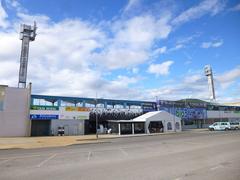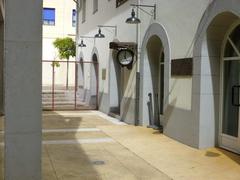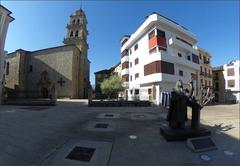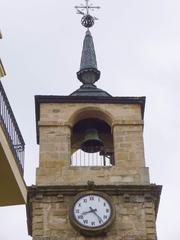
Santiago de Peñalba Visiting Hours, Tickets, and Ponferrada Historical Sites Guide
Date: 04/07/2025
Introduction to Santiago de Peñalba and Its Historical Significance
Tucked away in the tranquil Valle del Silencio in the Bierzo region of León, Spain, Santiago de Peñalba is a living testament to Spain’s medieval past. The village’s centerpiece, its 10th-century Mozarabic church, exemplifies the fusion of Christian and Islamic artistry that flourished during the early Middle Ages. Established under the guidance of San Genadio, this monument stands as one of Spain’s finest and best-preserved examples of Mozarabic architecture, renowned for its horseshoe arches, intricate stonework, and evocative frescoes.
Santiago de Peñalba’s remote setting in the Montes Aquilanos has protected its medieval character. Stone houses with wooden balconies, pedestrian-only cobbled streets, and a serene landscape invite visitors to step back in time. The area, known as the Tebaida Berciana, was once a vibrant spiritual center and remains a haven for those seeking history, culture, and the peace of nature.
This comprehensive guide brings together the essential history, architectural highlights, visitor information, and practical travel tips for Santiago de Peñalba, while emphasizing the importance of sustainable tourism to preserve its unique heritage. For further context and planning, consult the official Spain tourism portal, Miventanaalmundo, and Barceló Experiences.
Contents Overview
- Early Origins and Monastic Foundations
- The Mozarabic Church: Architectural and Religious Significance
- Medieval Isolation and Preservation
- The Tebaida Berciana: A Spiritual and Cultural Landscape
- Rediscovery and Modern Recognition
- Practical Visitor Information
- Visiting Hours and Tickets
- Accessibility
- Getting There
- Nearby Attractions
- Conservation and Visitor Experience
- Setting and Village Life
- Local Traditions and Gastronomy
- Visuals and Media
- Related Articles
- Frequently Asked Questions (FAQ)
- Conclusion and Call to Action
Early Origins and Monastic Foundations
Santiago de Peñalba’s story begins in the 7th century, when San Fructuoso, Bishop of Braga, founded an oratory in the Valle del Silencio (miventanaalmundo.com). This spiritual tradition was continued and expanded under San Valerio, and especially by San Genadio, Bishop of Astorga in the 10th century. According to local legend, San Genadio silenced the river so he could meditate, bestowing the valley its name. Under his leadership, a thriving monastic community grew, shaping the area’s religious and architectural legacy.
The Mozarabic Church: Architectural and Religious Significance
The heart of Santiago de Peñalba is its Mozarabic church, built in the 10th century and heralded as one of Spain’s best-preserved examples of this unique architectural style (peñalbadesantiago.es). Mozarabic architecture, developed by Christians living under Muslim rule, is characterized by horseshoe arches and a blend of Visigothic, Asturian, and Islamic influences. The church’s cross-shaped floor plan, marble columns, and understated ornamentation testify to the era’s artistic synthesis. Declared a National Monument in 1931 and a Bien de Interés Cultural, the church remains a locus of spiritual life and a magnet for art and history enthusiasts.
Medieval Isolation and Preservation
Santiago de Peñalba’s remote mountain setting shielded it from the rapid changes of history. The village retains its medieval architecture—thick stone walls, slate roofs, and wooden balconies—unchanged for centuries. Vehicles are prohibited within the village, preserving its tranquil, pedestrian-friendly environment (Packing Up The Pieces). Recognized as a “Paraje Pintoresco” (Scenic Site) in 1969, Santiago de Peñalba is also listed among “Los Pueblos Más Bonitos de España” (The Most Beautiful Villages of Spain), a testament to its exceptional heritage and preservation efforts (Barceló Experiences).
The Tebaida Berciana: Spiritual and Cultural Landscape
The Valle del Silencio and surrounding Tebaida Berciana region flourished as a center of Christian monasticism from the 7th to the 10th centuries, inspired by Egypt’s Thebaid Desert. The area is dotted with hermitages and monasteries, including the Cueva de San Genadio, a site of pilgrimage and legend (miventanaalmundo.com). Today, hiking trails connect these sites, enabling visitors to explore the region’s spiritual and natural heritage.
Rediscovery and Modern Recognition
After centuries of relative obscurity, Santiago de Peñalba has emerged as a highlight for cultural tourism and heritage preservation. Its proximity to alternative Camino de Santiago routes has increased its visibility, while its designation as a Bien de Interés Cultural underscores its historical and architectural significance (miventanaalmundo.com).
Practical Visitor Information
Visiting Hours and Tickets
- Church Hours: Open daily from 10:00 AM to 6:00 PM (April–October), and 10:00 AM to 4:00 PM (November–March). Hours may vary on holidays or for religious events—confirm with the official site before visiting (Spain.info).
- Tickets: Entrance is around €3 for adults, with discounts for children, seniors, and groups; free for children under 7 or 12, depending on the season.
- Guided Tours: Available in Spanish and sometimes English, offering insights into the church’s history and architecture. Advance booking is recommended during peak seasons.
Accessibility
The village features narrow, cobbled streets and steep paths. While some areas of the church are wheelchair accessible, overall accessibility is limited. Visitors with mobility issues should contact the local visitor center for the latest information.
Getting There
- By Car: From Ponferrada (20–25 km, about 40 minutes), follow the scenic but winding LE-158 or LE-CV-192/21. There is no public transport; taxis or organized tours are alternatives (Novo-Monde).
- Parking: Required at the village entrance; cars are not permitted inside.
Facilities
- Dining: Two village restaurants, Aromas del Oza and La Cantina, serve local specialties (Barceló Experiences).
- Accommodation: Limited rural guesthouses; book early, especially in high season.
- Shops: None in the village; Ponferrada is the nearest service hub.
Best Time to Visit
Spring and autumn offer mild weather and vibrant landscapes. Early mornings and evenings are especially peaceful, as most day visitors depart (Packing Up The Pieces).
Conservation and Visitor Experience
Santiago de Peñalba’s preservation is a joint effort between local authorities and residents. Conservation initiatives protect the church’s structure and art, while visitor impact is carefully managed. The village’s quiet lanes, traditional homes, and spiritual ambiance provide a unique setting for contemplative exploration. Visitors are asked to respect local customs, dress modestly, and minimize noise, particularly near the church (peñalbadesantiago.es).
Setting and Village Life
At 1,100 meters altitude, Santiago de Peñalba is a model mountain village, its life shaped by tradition and nature (Barceló Experiences). The cobbled streets wind between slate-roofed stone houses, and with a population of fewer than 25 residents, the atmosphere is one of deep quiet and community. Livestock and small-scale agriculture remain economic mainstays (Wikipedia). Community festivals, like the feast of Saint James on July 25th, blend religious observance with lively gatherings (Senditur).
Local Traditions and Gastronomy
The village’s annual feast of Saint James, held on July 25th, features religious ceremonies, communal meals, and traditional customs. Pilgrims often visit the Cueva de San Genadio, taking home a sachet of soil believed to hold healing powers (Senditur). Local cuisine is hearty and rustic, with specialties like botillo (cured pork) and cecina (air-dried beef), often enjoyed with Bierzo wines.
Natural Surroundings and Outdoor Activities
Santiago de Peñalba is a gateway to the Valle del Silencio’s pristine nature. The most popular walk is the short, well-marked trail to the Cave of San Genadio (2 km round trip). Other hiking routes include the Way of the Blacksmiths, the Way of Silence, and the Tebaida Berciana loop, providing access to panoramic vistas, forests, and centuries-old hermitages (Senditur).
Visuals and Media
For a richer understanding, explore high-quality images and virtual tours on official tourism websites. Interactive maps and virtual experiences are available to help plan your visit.
Related Articles
Frequently Asked Questions (FAQ)
Q: What are the visiting hours for Santiago de Peñalba and its church?
A: The church typically opens 10:00 AM–6:00 PM (April–October) and 10:00 AM–4:00 PM (November–March). Confirm before visiting, as hours may change.
Q: Is there an entrance fee?
A: Yes, around €3 for adults. Discounts apply for children and seniors; children under 7 or 12 are usually free.
Q: Are guided tours available?
A: Yes. Tours in Spanish (and sometimes English) can be booked in advance.
Q: How do I get there from Ponferrada?
A: By car, via the LE-158 or LE-CV-192/21. No public transport is available; parking is at the village entrance.
Q: Is the site accessible for people with mobility issues?
A: Accessibility is limited due to steep, cobbled streets. Some areas of the church are adapted. Contact local services for details.
Conclusion and Call to Action
Santiago de Peñalba is a rare blend of architectural beauty, spiritual depth, and natural tranquility. Its preserved medieval village and Mozarabic church offer a singular journey into Spain’s cultural heritage. Plan your visit by checking official hours, ticketing, and accessibility, and be sure to experience local traditions and trails. Support sustainable tourism by respecting the village’s quiet rhythms and contributing to its ongoing preservation.
For the latest updates, travel tips, and interactive resources, visit the official Spain tourism website, Miventanaalmundo, and Barceló Experiences. Enhance your journey with the Audiala app, and follow us on social media for real-time news, maps, and curated guides.
Sources and Official Links for Santiago de Peñalba
- Miventanaalmundo: History, Tickets, and Travel Tips
- Spain.info: Church of Santiago de Peñalba
- Barceló Experiences: Things to Do in Peñalba de Santiago
- Spain.info: Ponferrada Travel Information










